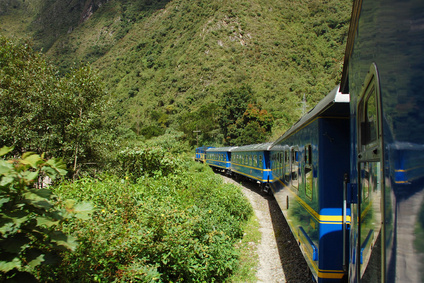Tourist information: Transportation
 The region of Machu Picchu after the entrance of the sanctuary of the citadel in the historic Unesco World Heritage was at the prospect of sharing her story with countless visitors that still continue to show their keen interest every year. This is why it was necessary to provide with a series of question of transport infrastructure that could facilitate the entrance of tourism such inaccessible area.
The region of Machu Picchu after the entrance of the sanctuary of the citadel in the historic Unesco World Heritage was at the prospect of sharing her story with countless visitors that still continue to show their keen interest every year. This is why it was necessary to provide with a series of question of transport infrastructure that could facilitate the entrance of tourism such inaccessible area.
The first and most common form of transport is the train crossing but there are also other lines of buses and trains to many other parts of the region. The route intrain Cuzco - Aguas Calientes is without a doubt the best option to reach Machu Picchu; it is owned by the British company PeruRail which enabled the Machu Picchu area to make it easily accessible for tourism. The journey begins in the city of Cuzco and ends in a former settlement Maquinachayoq, approximately 110 kilometers where, at the beginning of the last century, became the first uprising of which is now the town known as Aguas Calientes; every day, offer different schedules on the basis of the station of San Pedro of Cuzco, close to the Huánchac market. The attractiveness of this path focuses on the journey of rise during the first minutes of the trip offering spectacular views to the passenger; the rise continues until you reach "El Arco", highest point in the Northeast part of the city; Once past this point, the route crosses the villages of Izcuchaca, Cachimatyo and Poroy, until you reach the cattle pasture area known as the Pampa of Anta. Hence the journey passes through the depression known as Pomatales until station Pachar in the sacred Inca Valley, after crossing the Urubamba River through the bridges in ruins, where the trip ends to get to the last station of Ollantaytambo. There are different rates for the traveler depending on the characteristics and conditions of the trip:
- local train: strictly reserved for Peruvian residents to be able as well to provide a channel of communication for the inhabitants of the areas. The use by international tourists is strictly prohibited.
- Expedition: this line is exclusively designed for those travelers seeking a little adventure over on his trip. It is also known as backpacker train or train backpacking by the wide spaces designated for the bags of passengers.
- Vistadome: is the faster and more comfortable as well as the most spectacular as the design of the car covered by large Windows offers excellent panoramic views.
- Hiram Bingham: Orient Express train which provides the passenger with all kinds of amenities and first-class service, acquired the status of one of the most luxurious trains in the world.
There are other shorter train routes that pass through the interior of the Sacred Valley and ending at Machu Picchu; these voyages depart from Ollantaytambo and Urubamba stations, and have cars with transparent roofs to show a better view of the panorama.
Route of bus Aguas Calientes - Machu Picchu transports visitors from the bridge ruins train station to Machu Picchu via the route Hiram Bingham of 5.30 at 17: 00.
The other possibility for travelers is to make walking to Machu Picchu, Inca Trail ideal for lovers of nature and one of the best districts for hiking in South America. The average is 4 days and the journey may begin either from the Piscacucho, from where you can cross the suspension bridge of the Urubamba River, or from the ruins of Qoriwayrachina.